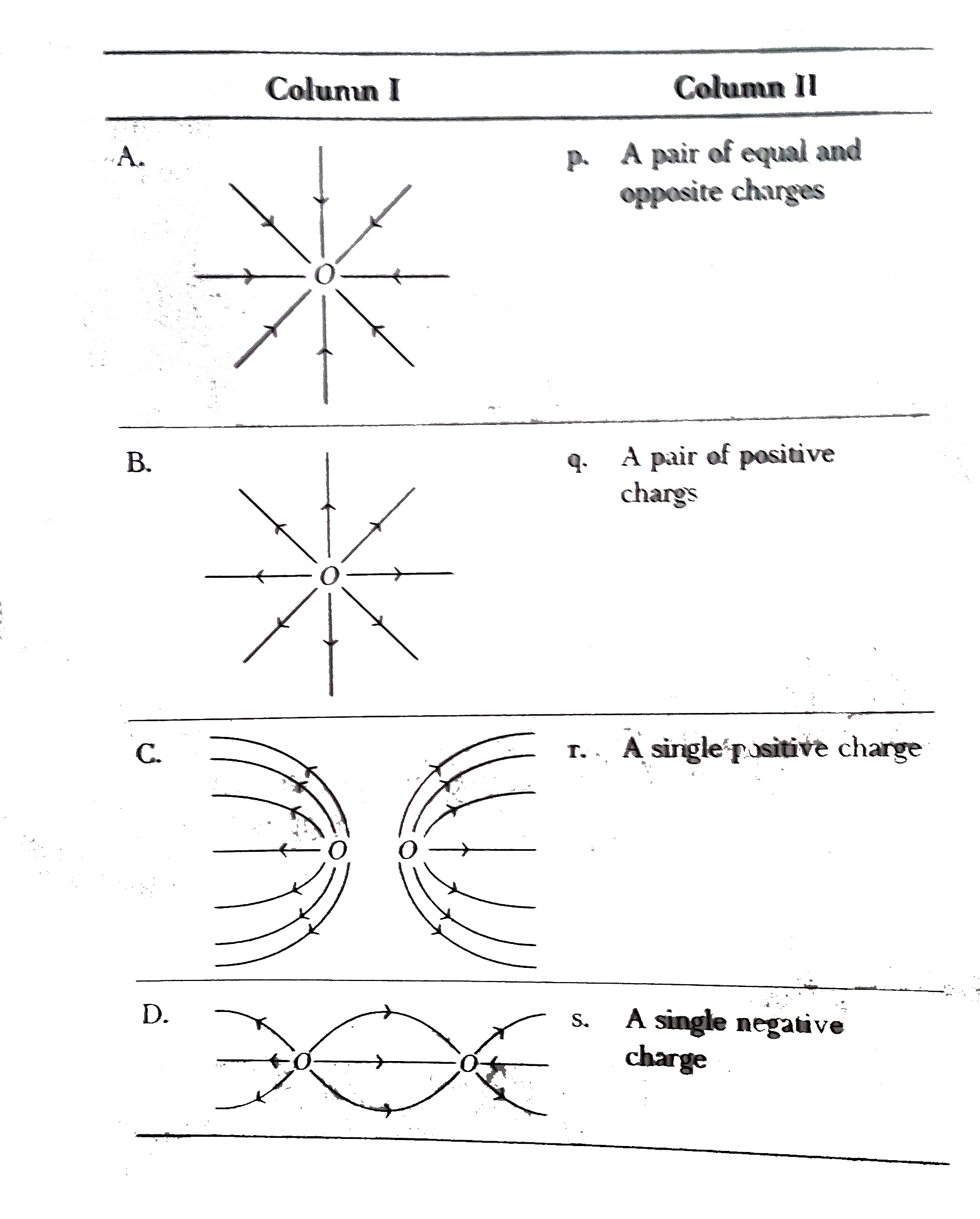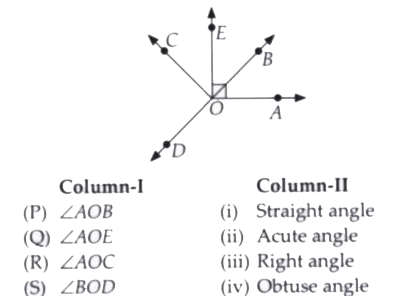Column I shows distributionof electric field liness and column II shows charge distribution . Match the columns.
Column I Column II(A)Straight lines but not parallel(p)Uniformly distributed charged shell(B)Straight lines but parallel (q)Uniformly distributed charged long rod(C)Curved lines(r)Uniformly distributed infinite charged sheet(D)Some regions where no lines are present(s)Electric dipole(t)Any conducting material
The correct Answer is:A(p,q),B( r),C(s),D(p,t)
Topper's Solved these Questions
- ELECTRIC CHARGES AND FIELDS BOOK - AAKASH INSTITUTECHAPTER - ELECTRIC CHARGES AND FIELDS EXERCISE - SECTION-G(INTEGER ANSWER TYPE QUESTIONS)
1 Videos
- ELECTRIC CHARGES AND FIELDS BOOK - AAKASH INSTITUTECHAPTER - ELECTRIC CHARGES AND FIELDS EXERCISE - SECTION-H( MULTIPLE TRUE-FALSE QUESTIONS)
10 Videos
- ELECTRIC CHARGES AND FIELDS BOOK - AAKASH INSTITUTECHAPTER - ELECTRIC CHARGES AND FIELDS EXERCISE - SECTION E(ASSERTION -REASON TYPE QUESTIONS)
10 Videos
- DUAL NATURE OF RADIATION AND MATTER BOOK - AAKASH INSTITUTECHAPTER - DUAL NATURE OF RADIATION AND MATTER EXERCISE - ASSIGNMENT (SECTION-D)
10 Videos
- ELECTROMAGNETIC INDUCTIONBOOK - AAKASH INSTITUTECHAPTER - ELECTROMAGNETIC INDUCTIONEXERCISE - ASSIGNMENT(SECTION -D) Assertion-Reason type Question)
15 Videos
Similar Questions
Match the field lines given in Column I with charge configuration due to which field lines exist in Column II.

View SolutionStudy the given figure carefully. If DOB is a straight line, then match the columns.

Column - IColumn - II(P)∠AOB(i)Straight angle(Q)∠AOE(ii)Acute angle(R)∠AOC(iii)Right angle(S)∠BOD(iv)Obtuse angle
View Solution
Knowledge Check
Match the field lines given in Column I with charge configuration due to which field lines exist in Column II.
 AA−S , P−R , C−Q , D−PBA−R , P−S , C−Q , D−PCA−S , P−Q , C−R , D−PDA−P , P−R , C−Q , D−S
AA−S , P−R , C−Q , D−PBA−R , P−S , C−Q , D−PCA−S , P−Q , C−R , D−PDA−P , P−R , C−Q , D−SAssuming only electrostatic forces are present, electric field lines in the space surrounding a charge distribution show
AOnly the directions in which static charges would accelerate when at points on those lines.BOnly the directions in which moving charges would accelerate when at points on those lines.CTangents to the directions in which either static charges or moving charges would accelerate when passing through points on those lines.DThe paths static or moving charges would take.
Column I shows charge distribution and column II shows electrostatic field created by that charge at a point r distance from its centre.
(,Column I ,,Column II),((A),A stationary point charge,(p),E∝r0),((B),A stationary uniformly long charge rod,(q),E∝r1),((C),A stationary electric dipole,(r),E∝r⋅−1),,(s),E∝r−2),(,,(t),E∝r−3):}
View SolutionColumn I shows charge distribution and column II shows electrostatic field created by that charge at a point r distance from its centre.
(,Column I ,,Column II),((A),A stationary point charge,(p),E prop r^(0))),((B),A stationary uniformly long charge rod,(q),Eprop r^(1)),((C ),Astationarye≤ctricdipo≤,(r ),E∝r⋅−1),(s),E∝r−2),(,,(t),E∝r−3):}
View SolutionColumn I shows different charge distributions and short electric dipole at a distance x from the charge distributions. Column II gives the dependence of force acting on the dipole as of function of x.

View SolutionIf some charge is given to a conducting object of any shape, then match the following columns, under electrostatic condition
Column IColumn II(A)→E at a point within conducting material(p)Must be zero(B)→Eat a point outside the material (q)May be Zero(C)→Eat a point in a cavity having no charge(r)May be uniform but not zero(D)→Eat a point in the cavity having some charge(s)May be non-uniform(t)Cannot predict
View SolutionIf some charge is given to a conducting object of any shape, then match the following columns, under electrostatic condition
Column IColumn II(A)→E at a point within conducting material(p)Must be zero(B)→Eat a point outside the material (q)May be Zero(C)→Eat a point in a cavity having no charge(r)May be uniform but not zero(D)→Eat a point in the cavity having some charge(s)May be non-uniform(t)Cannot predict
View Solution∮→E.d→s= Electric flux through a closed surface 's'
Match the column :
Column IColumn II(A)The value of∮→E.d→s is affected by (p)+ve charge inside 's'(B)Electric field at a point inside 's' is affected by(q)−vecharge inside 's'(C)Electric field at a point outside 's' is affected by (r)+ve charge outside 's'(D)Electric field at a point at the surface of 's' is affected by (s)-ve charge outside 's'(t)Outside charges but very far away from 's'
View Solution
